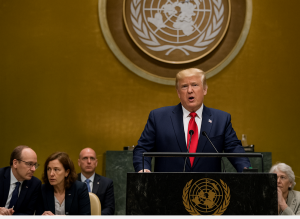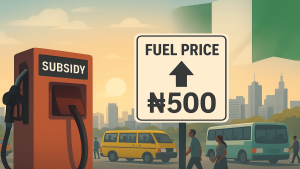How Nigeria Is Changing After Fuel Subsidy Removal: The Real Impact on Economy and Everyday Life
7 min read
Nigeria post subsidy removal
The phrase “Nigeria post subsidy removal” has become a defining topic in the nation’s recent economic history. Since the removal of the fuel subsidy in mid-2023, Nigerians have experienced a complete transformation in the way they live, work, and manage their daily expenses. This policy decision, made under the administration of President Bola Ahmed Tinubu, was described as necessary for long-term stability — but it has also triggered short-term pain for millions of citizens.
In this article, we’ll explore how Nigeria is evolving post-subsidy removal, analyzing the economic impact, social adjustments, opportunities for reform, and what the future may hold for Africa’s largest economy.
The Background: Why the Subsidy Was Removed
For decades, Nigeria maintained one of the most expensive fuel subsidy programs in the world. The government spent billions annually to keep fuel prices artificially low for citizens. While this seemed beneficial on the surface, it created major fiscal problems.
By 2022, fuel subsidies were draining over ₦4 trillion annually — a figure that rivaled the nation’s entire education and healthcare budgets combined. The subsidy system also encouraged corruption, smuggling, and inefficiency in the downstream oil sector.
The Tinubu administration argued that continuing the subsidy was unsustainable. Nigeria was spending more on cheap fuel than on developing critical infrastructure, health, and education. Hence, the decision was made in May 2023 to remove the fuel subsidy entirely — ushering in what we now call Nigeria post subsidy removal.
Immediate Effects: Rising Prices and Inflation
The most visible change in Nigeria post subsidy removal has been the sharp rise in fuel prices. Within days, the pump price of petrol (PMS) jumped from around ₦185 per liter to over ₦500 in many parts of the country — and in some states, even higher.
This surge in fuel prices quickly rippled through the economy:
Transportation costs skyrocketed as bus fares and delivery charges rose.
Food prices increased due to higher logistics and storage costs.
Electricity and generator expenses — crucial in a nation with unstable power — doubled or tripled for small businesses.
Inflation soared to over 30%, one of the highest in decades. The cost of living in Nigeria became unbearable for many, forcing households to cut spending, reduce travel, and prioritize survival over comfort.
While the government promised palliative measures, many citizens have yet to feel the full benefit.
The Economic Rationale: Why It Still Makes Sense
Despite the hardship, economists argue that the fuel subsidy removal in Nigeria was a necessary evil. Subsidies are widely considered inefficient and regressive — meaning the wealthy, who use more fuel, benefit more than the poor.
By removing the subsidy, the government freed up funds for other crucial sectors. The Nigerian National Petroleum Company Limited (NNPCL) can now operate more transparently without the burden of hidden subsidy costs.
In the long term, this move should:
Encourage competition in the petroleum market.
Attract investment into local refining and energy infrastructure.
Reduce smuggling of cheap Nigerian fuel to neighboring countries.
Improve fiscal discipline by redirecting funds to development projects.
Essentially, Nigeria post subsidy removal is meant to shift the nation from consumption to production — from dependency to sustainability.
Social Impact: The Struggles of Ordinary Nigerians
However, these macroeconomic benefits are not immediately visible to the average Nigerian. The everyday citizen has borne the brunt of this transition.
Workers now spend a larger share of their income on transportation. Small traders and market women find it harder to restock goods as transportation costs eat into profit margins. The middle class — once comfortable — now feels squeezed by rising school fees, rent, and household expenses.
The Nigerian Labour Congress (NLC) and several unions have staged protests, demanding wage increases and better social protection. Government responses include cash transfers, food distribution, and salary adjustments for public workers. Yet, implementation has been inconsistent.
In essence, Nigeria post subsidy removal has exposed deep socioeconomic inequalities — showing how fragile household economies truly are.
Business Response: Adapting to the New Reality
Businesses in Nigeria post subsidy removal are also adapting in different ways. Transport and logistics companies have adjusted prices or switched to more fuel-efficient vehicles. Ride-hailing platforms like Bolt and Uber have introduced “fuel cost surcharges” to cope with expenses.
Manufacturers are struggling with increased production costs due to higher fuel and electricity bills. Many small and medium enterprises (SMEs) — already burdened by inflation and foreign exchange volatility — are scaling down operations.
However, there’s also innovation emerging:
Companies are investing in solar energy and alternative power solutions.
Delivery and logistics firms are exploring electric motorcycles.
Local refineries like Dangote Refinery are expected to reduce dependence on imported fuel once fully operational.
Thus, the private sector is being forced to evolve — a crucial step for long-term economic diversification.
Government Interventions and Reforms
To cushion the effects of subsidy removal, the Nigerian government launched several initiatives under the Presidential Palliative Programme. These include:
- ₦5 billion grants per state to support food distribution.
- Cash transfers to vulnerable households.
- CNG (Compressed Natural Gas) buses to reduce transportation costs.
- Student loans and grants for tertiary education.
- Salary increases for federal civil servants.
While these efforts are commendable, execution remains the biggest challenge. Many citizens complain that the palliatives are insufficient, poorly distributed, or temporary.
For Nigeria post subsidy removal to truly succeed, structural reforms — not just emergency handouts — are needed. That means tackling corruption, improving power supply, strengthening local production, and promoting efficient tax systems.
The Role of Local Refining and Dangote Refinery
One of the major hopes for Nigeria post subsidy removal lies in local refining capacity. For years, Nigeria has paradoxically exported crude oil but imported refined fuel — a costly imbalance that fueled (no pun intended) the need for subsidies.
The Dangote Refinery, with a capacity of 650,000 barrels per day, is expected to change that narrative. Once fully operational, it can supply a significant portion of Nigeria’s fuel demand locally, reducing dependence on imports and stabilizing prices.
If the refinery meets expectations, it could help lower fuel prices over time — easing inflationary pressure and improving energy security.
This single infrastructure project could become one of the defining successes of Nigeria post subsidy removal.
Transportation and Urban Mobility Changes
Transportation is one of the most visible sectors hit by subsidy removal. With higher petrol prices, commuters in cities like Lagos, Abuja, and Port Harcourt now pay nearly double for daily rides.
Some urban areas are experimenting with alternative transportation models, including:
Electric minibuses and bikes for short-distance commuting.
Carpooling and ride-sharing systems to reduce fuel consumption.
Improved public transport planning through BRT and CNG bus systems.
If effectively implemented, these changes could make urban transport more sustainable in the Nigeria post subsidy removal era.
Inflation, Food Prices, and Household Spending
Inflation remains one of the toughest challenges in Nigeria post subsidy removal. Food prices have seen dramatic increases across the board — rice, garri, yam, beans, and bread all cost more.
For instance, a bag of rice that cost ₦32,000 before subsidy removal now sells for ₦55,000–₦60,000 in some markets. Transportation of goods from farms to cities has doubled, leading to higher retail prices.
Household budgets are shrinking, forcing many to downsize meals, postpone purchases, or seek extra income. The government’s minimum wage has not kept pace with inflation, making things worse for low-income earners.
In essence, Nigeria post subsidy removal has sparked a cost-of-living crisis that demands urgent and targeted solutions.
Potential Long-Term Benefits
Despite today’s pain, analysts believe that Nigeria post subsidy removal could yield significant long-term benefits — if managed well. These include:
Fiscal stability: The government can allocate funds to infrastructure, healthcare, and education instead of subsidies.
Private sector growth: Competitive fuel pricing may attract investors into the energy and transportation sectors.
Reduced corruption: Eliminating the opaque subsidy system reduces leakages and fraud.
Sustainable energy transition: Nigeria can now invest in renewable energy alternatives like solar and CNG.
These outcomes won’t appear overnight. But if the right policies follow, the reform could become a turning point for Nigeria’s economy.
Public Perception and Political Implications
Politically, Tinubu’s subsidy removal remains one of the boldest but most controversial decisions of his presidency. Some view it as a courageous step towards reform; others see it as a burden on already struggling citizens.
Public trust in government will depend largely on how well the savings from subsidy removal are utilized. If Nigerians begin to see tangible improvements in infrastructure, education, and healthcare, sentiment could shift positively.
For now, many Nigerians remain skeptical — waiting to see whether this sacrifice will truly bring change.
What the Future Holds
Looking ahead, Nigeria post subsidy removal could evolve in several directions. Success will depend on:
Efficient use of savings from subsidy removal.
Inflation control through better monetary policy.
Support for small businesses to withstand cost pressures.
Investment in local refining and renewable energy.
Transparent communication from government to rebuild public trust.
If these conditions are met, Nigeria can transition from crisis to recovery — from dependency to development.
A Nation in Transition
The story of Nigeria post subsidy removal is still being written. It’s a complex mix of pain and potential — of hardship today for the promise of a better tomorrow.
Fuel prices may have risen, inflation may be biting, and public frustration may be high, but the reform could lay the foundation for a stronger, more self-sufficient Nigerian economy.
As the nation continues this journey, the challenge will be balancing economic logic with social compassion — ensuring that the burdens of reform do not crush the hopes of its people.
Only then can the vision of a stable, prosperous Nigeria post subsidy removal become reality.







